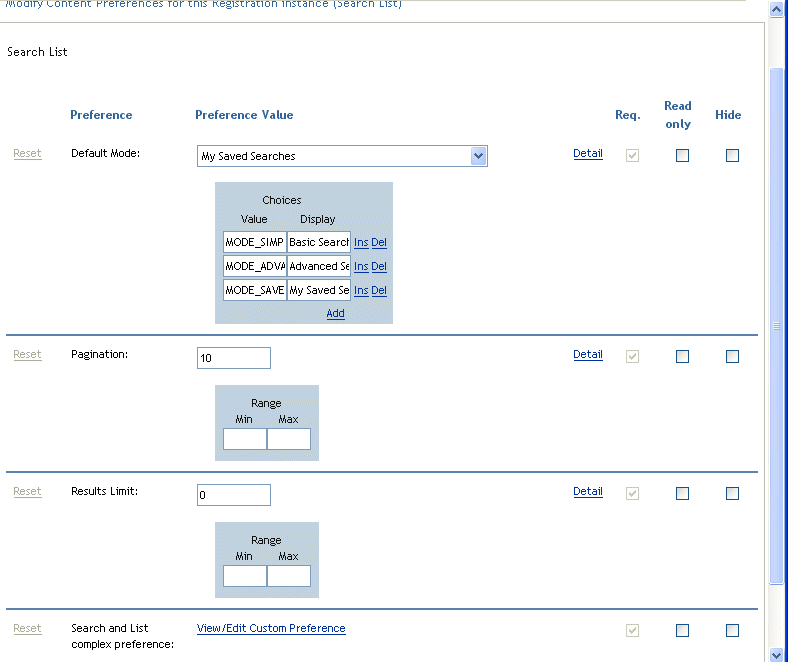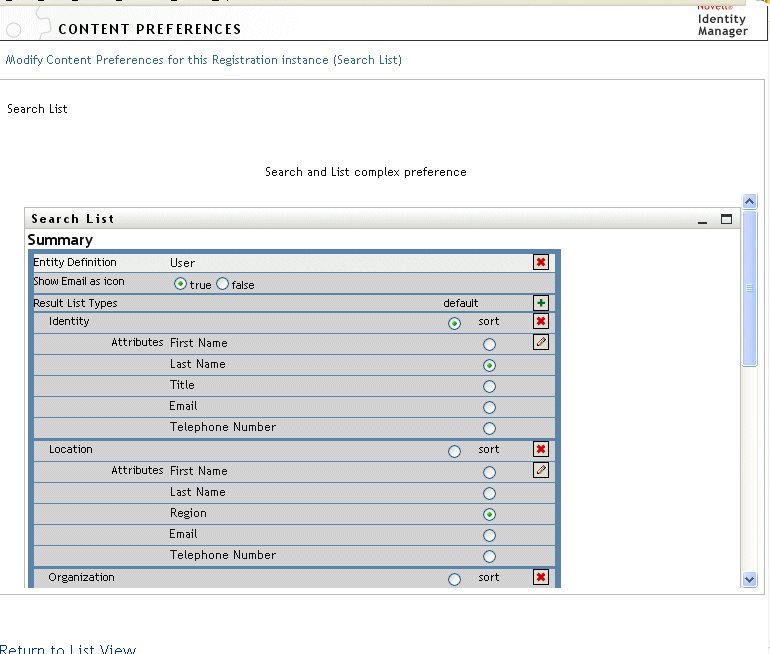20.2 Configuring the Search List portlet
To configure the Search List portlet, you’ll follow a set of steps like these:
|
Step |
Task |
Description |
|---|---|---|
|
1 |
Define:
|
You can use the predefined Directory Search action that gets installed with the Identity Manager user application as-is. You can modify it, or you can create your own. For more information, see Section 20.2.2, Setting Search List preferences. |
|
2 |
Verify that the set of entities and attributes for searching are defined in the directory abstraction layer. |
For more information, see Section 4.0, Configuring the Directory Abstraction Layer. |
|
3 |
Determine how you want users to access the portlet. |
Do you want users to launch this portlet from an existing or a new page? For more information about pages, see Section 7.0, Page Administration. |
|
4 |
Set preferences for the portlet |
Preferences for the search list portlet let you define:
For more information, see Section 20.2.2, Setting Search List preferences |
|
5 |
Test your settings |
Verify that the results lists show the desired attributes. |
|
6 |
Set eDirectory rights and establish any indexes needed to enhance performance |
eDirectory rights: To execute a search
To save a search (for non-Administrative users):
|
|
Performance enhancement—The performance of the search can be improved by adding an eDirectory value index to the attribute on which the search is based. |
For more information on defining different results list display formats, see Section 20.2.2, Setting Search List preferences.
20.2.1 Directory abstraction layer setup
The entities and attributes that can be selected from the search criteria dropdown and data returned from the identity vault searches must be defined in the directory abstraction layer. The following table shows the properties that you should set for the entities and attributes used by search list.
Other Directory abstraction layer settings The directory abstraction layer data type, format type, filters, and search scope will also impact the Search List portlet. The data type and format type affect the appearance, the filter and search scope will affect how much data is returned.
For more information, see Section 4.3, Working with entities and attributes.
20.2.2 Setting Search List preferences
You define two types of preferences:
Search preferences
The search preferences are contained in a single preference page:

The search preferences are defined below:
Results List format preferences
The complex preferences page lets you define the entities to include in the search and how to format the results list. The default preferences page looks like this:

The complex preferences include:
|
Preference |
What to do |
|---|---|
|
Entity Definition |
Each object that is valid for searching (view=true) has a corresponding Entity Definition block on this preferences page. Use these preferences to:
You can add the object back to the search later by clicking Add Entity Definition (located at the bottom of the page) and completing the wizard selection panels. HINT:If an object does not appear in this list, but is listed in the directory abstraction layer, check the view modifier (on the entity object). If set to false then the entity cannot be used by the identity portlets. |
|
Show email as Icon |
When true and an Email attribute is specified in the results list, it will display as an icon. When false the Email attribute displays the full email address. The email attribute (whether text or icon) is a clickable mailto: link. |
|
Results List Types (default) |
Specifies the results list default format for the current entity. The default is used only when a different format is not selected by the current user. |
|
Results List display format block |
Specifies the display format (such as Identity, Location, or Organizational pages) and includes the set of attributes to include for the type. To remove a Results List Type:
This deletes the page type and all of its associated attributes from the search. To add a result set page:
|
|
Attributes |
Specifies the set of attributes that will be displayed for the particular display format. To add or remove an attribute:
Attributes and data types—The attribute’s data type affects the way it is displayed. For example, if an attribute is defined as a sub-type of local list or global list then possible values are displayed in a dropdown list box in the Basic or Advanced Search Criteria screens. If the type is DN then a finder and history button are displayed to allow users to select a value in the Basic or Advanced Search Criteria screens, and the DN will be resolved to a user-friendly display in the results list. The data type and sub-type also restrict the comparison operator displayed for the user to ensure that only valid comparisons are constructed. For more information, see Section 4.0, Configuring the Directory Abstraction Layer. |
|
Results List display format block Sort |
The sort order for the Results List is based on this attribute. The default sort order only takes effect if the Result Set Type is not the display format for the current user session. Multi-valued attributes and single-valued attributes—The number of records displayed in a results list will vary depending on whether the sort attribute is single- or multi-valued. Sorting on multi-value attributes will generally appear to result in more records although the total number of matches remains the same. This is because each value of a multi-valued attribute is shown on a line by itself. |
Completing the preferences panel
To verify that you’ve submitted valid entries, click Submit. If an entry is invalid, you’ll see an error message displayed at the top of the preferences page. Once you are able to resolve all of the errors, click Return to List View, then click Save Preferences.